Certain soils, called Spodosols, are found in coastal areas of South Carolina, have a subsoil identified as rich in organic matter, and are appealing for use as landscaping root zone soil. In fact, the subsoil is a poor growing medium because it is very acidic and high in aluminum (Al3+). This article informs producers and farmers, homeowner associations, developers, landscape contractors, and construction companies about Spodosols, where they are found, how to identify them, and management strategies.
Not All Organic Matter is Good
Along the South Carolina coast, there is a type of soil (referred to as Spodosols) that has an organic-rich subsoil that lacks most of the benefits associated with soil organic matter. The subsoil (referred to as spodic horizons) has a dark color making it easy to assume it has nutrient-rich organic material, can buffer against pH changes, and is only slightly acidic. However, looks can be deceiving. These soils do not hold the same beneficial properties that most soils with organic matter offer for plant growth. Instead, these soils are characterized as having a low buffering capacity, can be very acidic (many have pH values < 4.0), and can have high soluble aluminum ion (Al3+) concentrations that are toxic to many plants.1 The acidity is caused by the accumulation of humus (decomposed organic material) and Al3+.1 If the soil material is used as a landscape substrate and not properly amended, plants struggle to survive and may eventually die.
Characteristics of Spodosols
Soils are classified into Soil Orders. Spodosols are an order most commonly found in the northern and southeastern regions of the United States (figure 1). Aquods are a suborder of Spodosols defined by having an aquic moisture regime, that is, a seasonal water table at or near the soil surface (figure 2).1 Aquods in South Carolina are typically associated with pine flatwoods of the lower Coastal Plain landscape (figure 3). Pine trees dominate the ecosystem, so the litter is primarily composed of pine needles. When the needles decompose, the by-product assists in the formation of the spodic horizon. Today many of these pine flatwoods have been developed for urban and agricultural purposes.
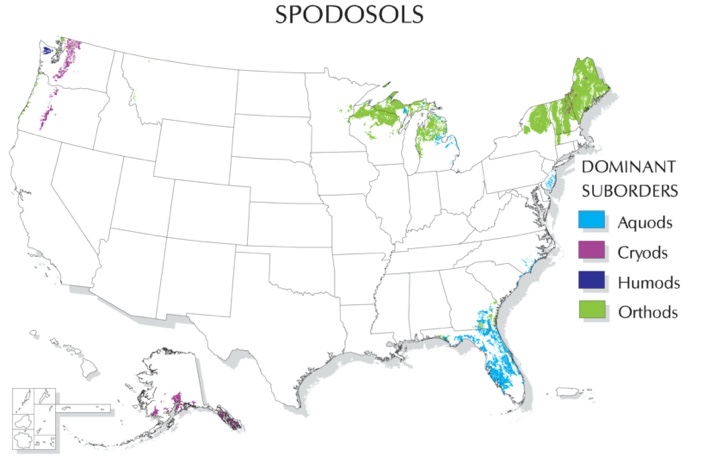
Figure 1. The distribution of the dominant suborders of the soil order, Spodosols in the United States. Image Credit: USDA Natural Resource Conservation Service.1
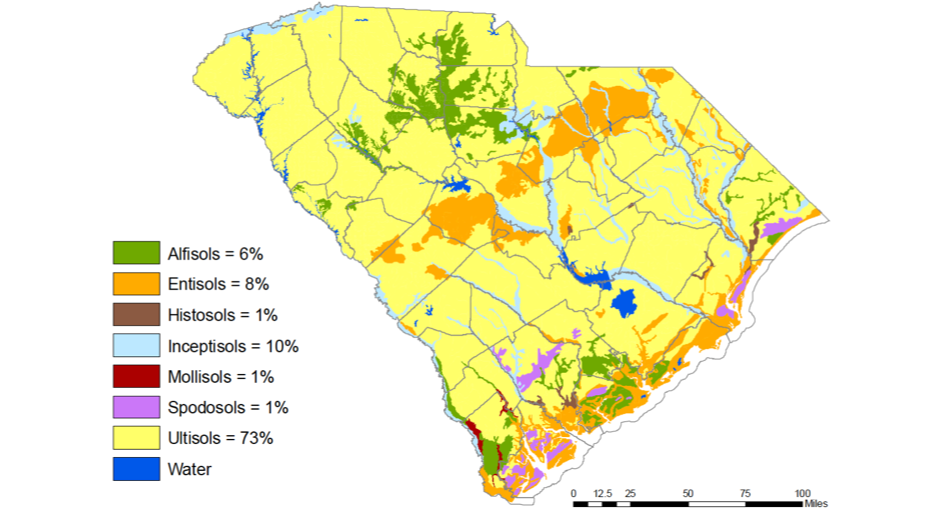
Figure 2. Dominant soil orders of South Carolina. Image Credit: D. Park and D. White. The Nitty Gritty of South Carolina Soils. Clemson University Creative Inquiry 2014.
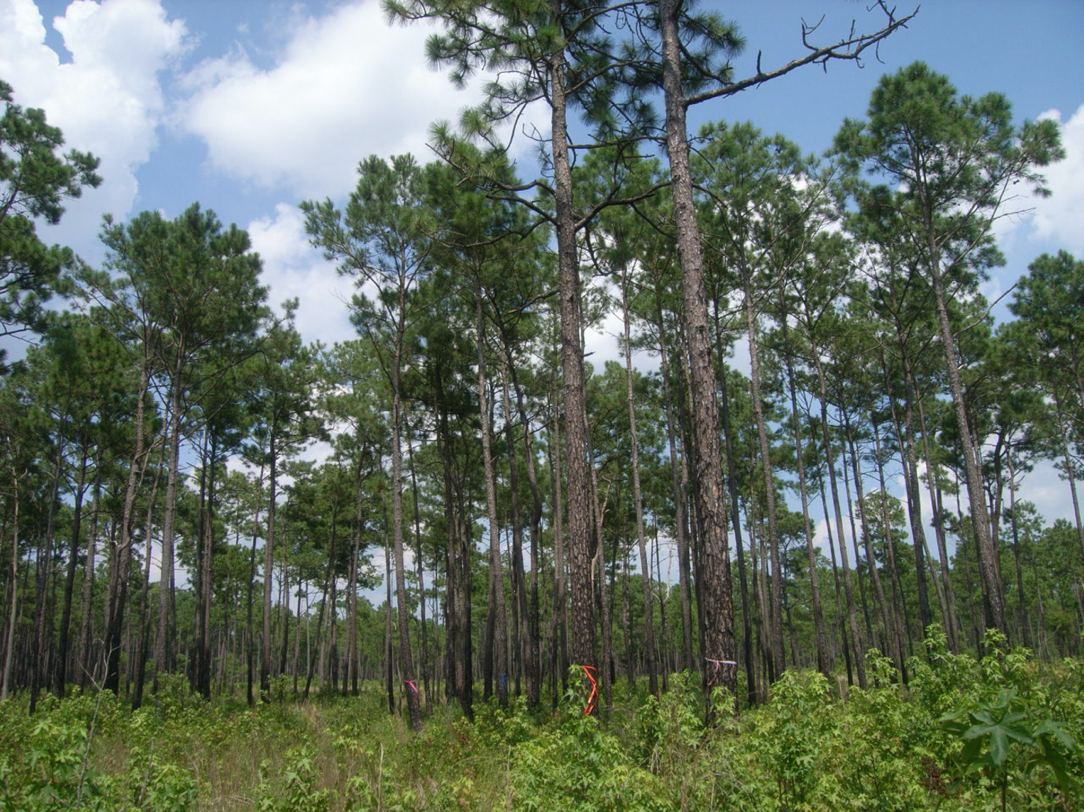
Figure 3. Spodosols primarily form along the coast of South Carolina in flatwoods. Today they are found under a variety of land uses, including pine plantations, row crop and vegetable agriculture, and urban communities. Image Credit: Thomas Williams.
Acidity
Pine needles have very few base cations and contain acidic resins. On the tree, the pine needles do not cause any concern. However, when the needles fall to the ground and slowly decompose, organic acids are released. These organic acids attack soil minerals and mobilize the Al3+ is released within the soil system.2 The acids and the Al3+ are mobile in the near-surface groundwater, making both water and soil very acidic.2 Acidification happens over a very long time. Pine needle mulches will not have the same effect when used in managed landscapes because needles have not been present and replenished for as many years as when found in an undisturbed forest.
Aluminum
A single Al3+ releases up to three hydrogen ions (H+) from a mineral particle. Along with H+, the Al3+ dominates the cation exchange complex (the sites on mineral particles where ions attach) as well as the soil solution. Aluminum toxicity is a major contributing factor to the decline in plant growth, including landscape plants and row crops.3,4,5 For example, the roots of many corn and soybean cultivars did not grow into subsoils saturated with Al3+.6 Plants with shallow roots will underperform by having their shoot growth inhibited, with a greater chance of mortality. Another example is tobacco. Tobacco plants grown in soils with high Al3+ concentrations had decreased physiological activities and overall growth.7
Identifying Spodosols
Spodosols identification is possible both virtually and in person. For virtual identification, select an area of interest (AOI) using the Web Soil Survey (WSS) and search for the presence of Spodosols. The WSS is a web application that is an inventory of soils in the United States. Developed by the US Department of Agriculture, Natural Resources Conservation Service, the WSS allows the user to identify soils in a particular area and determine the soil’s suitability for a particular use and chemical and physical properties. Access the WSS through the webpage listed above, which also contains information on how to navigate the web application. Once the AOI is identified, navigate to the “Soil Map” tab. Find the Map Unit in the table that represents the greatest percent of the AOI. Take the first word in the Map Unit Name and enter it in a search engine followed by “soil series.” Or navigate to the Official Soil Series Description website and enter the first word. For example, if the Map Unit Name is “Leon Sand,” the phrase “Leon soil series” is the correct search term. Under the taxonomic class, if the final letters of the last word are “-ods,” then the soil places in the Spodosols order.
Regardless of the virtual soil order identification, the soils’ order should be verified on-site. For assessments in new developments, where the area has never been disturbed, taking cues from the environment and doing a little digging can assist in identifying Spodosols. Traits to look for in the natural environment of an undisturbed site include
- Landscapes dominated by pine trees
- Pine needles on the soil surface
- Flat topography (none to minimal slope)
- Standing water may be present, or water is close to the surface
In many situations, disturbed environments are being redeveloped, and thus these environmental cues will not be present because pine trees were removed and drainage installed. In disturbed environments, digging is the only way to confirm the presence of a Spodosol.
Soil color also helps when identifying Spodosols. Below the surficial litter layer and dark brown organic layer (termed the O horizon), the mineral soil surface is usually pigmented with gray-black sand (figure 4). Some Spodosols have a white- or light-colored layer, sometimes with gray splotches (termed an E horizon), between the surface A horizon and the deeper spodic horizon (i.e., the subsoil of concern) (figure 4b). Organic acids released from the decomposing pine needles bind and remove aluminum and iron as they move with water percolating through the soil or with receding high-water tables. The organics, iron, and aluminum then precipitate to form the dark red to dark brown or black layers known as spodic horizons (figure 4b).2,8 The spodic horizons are the horizons commonly mistaken for typical organic-rich topsoil. Suspect subsoil material should always be further examined by collecting a soil sample and having it tested for pH and Al3+.
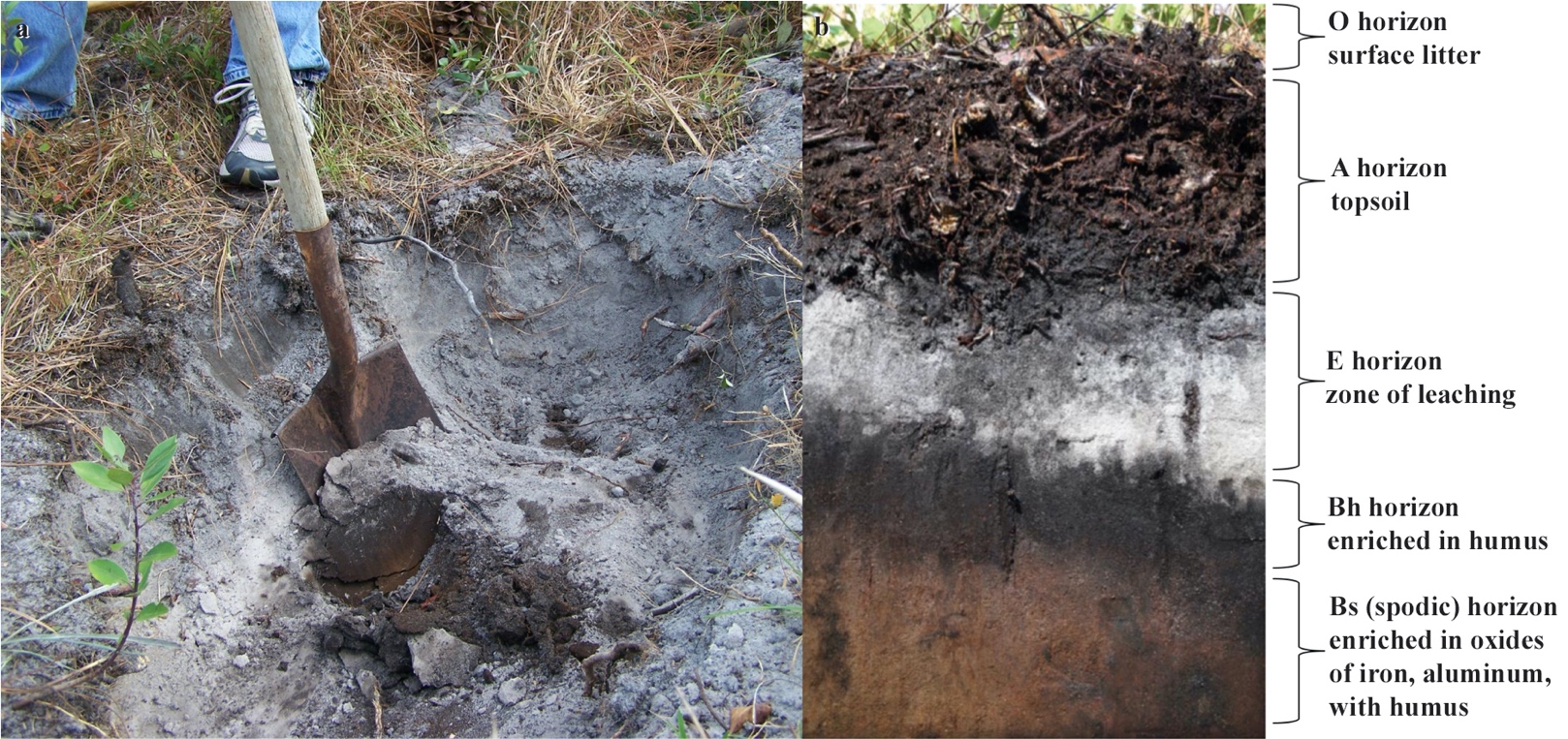
Figure 4. An undisturbed Spodosol may have a light-colored eluvial horizon just below the surface layer (a, left photo). The dark brown/black horizon underneath the whitish/grey horizon is the portion of the soil that is commonly mistaken for good organic soil for constructed landscape root zones (b, right photo). Image credit: Dara Park, Clemson University (left), and John Kelley, Clemson University (right).
Spodosols in Constructed Landscapes
When developing a land area, developers commonly save any disturbed soil material on-site that is high in organic matter. Later, the material is spread as topsoil for the planted landscape around the newly constructed buildings. Due to their location and natural aesthetic appeal, coastal pine flatwoods are highly desirable places to live. Developers will carve out ditches to drain the land. In doing so, the ditch spoils frequently contain the deceiving dark spodic subsoil. The reserved soil is saved for use in the planted landscape root zone. If purchasing bulk topsoil from a supplier, make sure to inquire about the source of the soil and if they have a chemical analysis.
Construction companies must use soils that meet structural and physical specifications. Soils used for foundations in construction must have a high resistance to compaction and erosion. The stability of the soil ensures the future well-being of the construction project. By focusing on the physical properties without considering the chemical properties, the head engineer determines what will work best for the site structurally, rather than what is best for the landscaping plants. Leftover fill soils are typically integrated into the final landscape around the infrastructure. It is best to avoid using spodic soil material as a root zone medium because of its adverse effect on plant health and survival.4
How Spodosols Reduce the Success of Planted Landscapes
Acidity and Fertility
Most plants perform best with a soil pH between 5.8 and 6.5. Within this range, plant nutrients like phosphorus, nitrogen, potassium, magnesium, and calcium, are in a form available for the plant to utilize.2 Figure 5 depicts plant nutrients available at different acidity levels. Beneficial soil microorganisms also prefer this pH range. Some nutrients are not available to plant roots at pH values below this range because they are bound to the Al3+, and thus are deficient in the soil.2,9
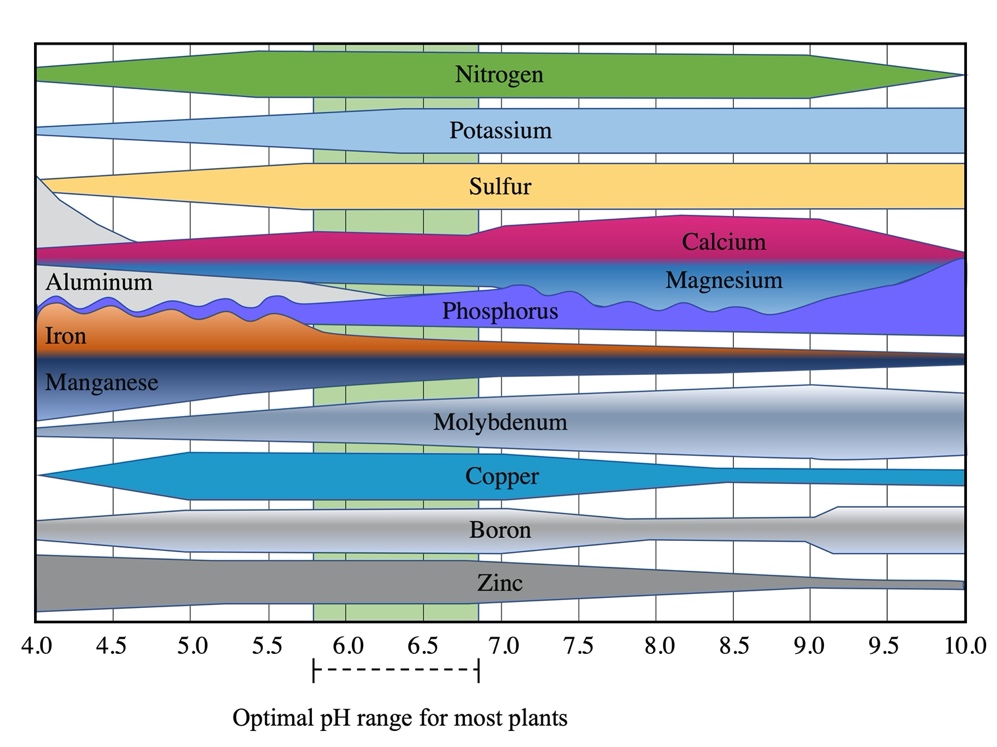
Figure 5. Availability of nutrients to plants over a pH range from 4–10. Image credit: Sarah White, Clemson University.
Aluminum Toxicity
As discussed above, Al3+ toxicity may also be an issue in landscapes with Spodosol fill soil. Common symptoms of Al3+ toxicity in plants include:
- Brown tipped, stunted roots
- Wilting (even when enough water is present because the damaged roots cannot take up water to meet plant demands)
- Purple plant stems (aluminum-induced phosphorus deficiency)2
How to Manage a Landscape Planted on Spodic Soils
Prevention is the best way to manage spodic soils. Check the soil’s chemical properties before its use as a root zone material. If the soil pH is near or below 5.0, then the soil should not be used.
If spodic soil is already present and cannot be replaced with a more desirable soil order, the following can be done:
- Soil Test: Regardless, if the topsoil is being brought in, or using the soil in place, collect a soil sample for chemical analysis both before planting and annually. Developing a baseline of information on the soil will allow for determining which amendments to use and to track soil changes over time.
- Select Appropriate Plant Material: Use native plants found in the surrounding natural environment. See table 1 for a list of native plants typically found in pine flatwoods in South Carolina.10,11 The Carolina Yards Plant Database can also be used to identify acid-loving plants (type “acid” in the search engine by region). Local Extension Agents and Master Gardeners can assist in identifying native and acid-loving plants and landscape nurseries that sell them. Many crops have been bred to tolerate low pH and high Al3+ soils.3 If growing crops in spodic soils, consult your Extension Agent, seed supplier, or both for names of Al3+ tolerant cultivars and varieties.
- Fertilization: When economically feasible, apply foliar fertilizers. Plant leaves directly absorb foliar fertilizers, reducing the need to modify soil pH to increase nutrient availability. Apply fertilizers at low application rates, but more frequently (known as “spoon-feeding”). When applying fertilizers to soils, use formulations that are base-forming, such as nitrate-based fertilizers (urea- and ammonia-based fertilizers are acid-forming).
- Apply Silicon: Silicon helps plants deal with stress.12
- Apply a Calcium Amendment: Calcitic and dolomitic lime assist in reducing Al3+ and overall acidity in surface soils. Lime also gives plants a source of calcium and magnesium. Fine-grade lime reacts faster than coarse lime sources.13 Use gypsum to replace Al3+ in subsoils. In both cases, determine amendment rates based from soil test CEC and % A1 saturation. Applying irrigation after application or timing application before rainfall is necessary for efficacy.
- Increase the Buffering Capacity: Topdressing with a quality organic material and applying lime increase the soils buffering capacity.
Table 1. Native plants found in South Carolina coastal pine flatwoods where Spodosols occur.11,12
| Common name | Scientific name | Type |
| Longleaf pine | Pinus palustris | Tree |
| Native blueberries | Vaccinium sp. | Shrub |
| Holly | Ilex sp. | Shrub |
| Saw palmetto | Serenoa repens | Dwarf palm |
| Pineland threeawn,
Beyrich threeawn |
Aristida stricta Michx.
Aristida beyrichiana Trin. & Rupr. |
Grass |
| Splitbeard bluestem,
Elliot’s bluestem |
Andropogon ternarius Michx.
Andropogon gyrans Ashe var. gyrans |
Grass |
| Little bluestem | Schizachyrium scoparium (Michx.) Nash | Grass |
| Indiangrass | Sorghastrum nutans (L.) Nash | Grass |
| switchgrass | Panicum virgatum L. | Grass |
Acknowledgments
The authors thank Adam Chastain for his assistance with the article.
References Cited
- Natural Resources Conservation Service. Spodosols map. United States Department of Agriculture, Natural Resources Conservation Service. [accessed 2020 Feb 15]. https://www.nrcs.usda.gov/wps/portal/nrcs/detail/soils/survey/class/maps/?cid=nrcs142p2_053608.
- Weil RR, Brady NC. The nature and properties of soils. 15th ed. Columbus (OH): Pearson; 2016.
- Kochian LV, Hoekenga OA, Piñeros MA. How do crop plants tolerate acid soils? Mechanisms of aluminum tolerance and phosphorus deficiency. Annual Review of Plant Biology. 2004 [accessed 2020 Jun 26];55:459-493. https://doi.org/10.1146/annurev.arplant.55.031903.141655.
- Rahman M, Lee SH, Ji H, Kabir A, Jones C, Lee KW. Importance of mineral nutrition for mitigating aluminum toxicity in plants on acidic soils: current status and opportunities. International Journal of Molecular Sciences. 2018 Oct [accessed 2020 Mar 8];19(10):3073–3075. doi:10.3390/ijms19103073.
- Foy CD, Chaney RT, White MC. The physiology of metal toxicity in plants. Annual Review of Plant Physiology. 1978 Jun [accessed 2020 Jun 26];29:511-66. doi:10.1146/annurev.pp.29.060178.002455.
- Bushamuka VN, Zobel RW. Maize and soybean tap, basal, and lateral root responses to a stratified acid, aluminum‐toxic soil. Crop Science. 1998 [accessed 2020 Feb 19];38(2):416–421. doi:10.2135/cropsci1998.0011183x003800020024x
- Yamamoto Y, Kobayashi Y, Devi SR, Rikiishi S, Matsumoto H. Aluminum toxicity is associated with mitochondrial dysfunction and the production of reactive oxygen species in plant cells. Plant Physiology. 2002 [accessed 2020 Feb 18];128:63–72. doi:10.1104/pp.010417
- Vasilas LM, Hurt GW, Berkowitz JF. Field indicators of hydric soils in the United States. Washington (DC): United States Department of Agriculture, Natural Resources Conservation Service; 2018 [accessed 2020 April 30]. https://www.nrcs.usda.gov/Internet/FSE_DOCUMENTS/nrcs142p2_053171.pdf
- Liang C, Piñeros MA, Tian J, Yao Z, Sun L, Liu J, Shaff J, Coluccio A, Kochian LV, Liao H. Low pH, aluminum, and phosphorus coordinately regulate malate exudation through GmALMT1 to improve soybean adaptation to acid soils. Plant Physiology. 2013 Mar [accessed 2020 June 21];161(3):1347-1361. doi:10.1104/pp.112.208934.
- Group Detail Report: G596. The U.S. National Vegetation Classification. 2015 [accessed 2020 April 30]. https://www1.usgs.gov/csas/nvcs/nvcsGetUnitDetails?elementGlobalId=857602
- Plants Database. United States Department of Agriculture, Natural Resources Conservation Service; 2019 [accessed 2020 April 30]. https://plants.usda.gov/.
- Feng J. Role of silicon in enhancing the resistance of plants to biotic and abiotic stresses. Soil Science and Plant Nutrition. 2011 Sep [accessed 2020 June 20]. 50:11–18. https://www.tandfonline.com/doi/abs/10.1080/00380768.2004.10408447.
- Delhaize E, Ryan PR. Aluminum toxicity and tolerance in plants. Plant Physiology. 1995 [accessed 2020 Feb 12];107(2):315–321. http://www.plantphysiol.org/content/107/2/315.

